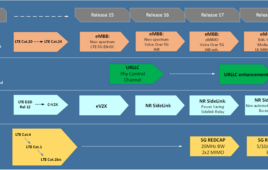Serious contenders are teeing up to attract developers to their preferred flavor of open source.
There’s a battle going on for the mindshare of mobile developers. Actually, it’s been going on for a while, but the stakes are getting higher as more companies get behind open source and developers make their choices.
First, there’s Linux Mobile and the Linux Mobile (LiMo) Foundation, which has been around for some time. Motorola, which has been working with open source platforms since 2003, has shipped more than 14 million Linux-based handsets to date. Second, there’s Android, a newer platform built on the open Linux kernel and advocated by the likes of Google and the Open Handset Alliance (OHA). Third – and although it’s not there yet – Symbian is going open source with Nokia’s plans to acquire the rest of the shares it doesn’t already own. The Symbian Foundation is expected to start operating during the first half of 2009.
Perhaps in the biggest display of grandeur, Google last year announced a $10 million Android Developer Challenge for developers building mobile applications for Android. The challenge is designed to support the developer community and spark innovation on the Android platform by awarding cash prizes ranging from $25,000 to $275,000. Google received at least 1,800 submissions for the first phase of the challenge, which is divided into two $5 million phases. Applications in the first top 50 applications included everything from a cab finder for calling a cab while in a foreign country to “cooking capsules” for quick dinner ideas.
WHY THE FUSS?
Why all this attention toward open source? Maybe it started with Linux, but Google raised awareness when it started pushing for open networks, which is separate from open source, but the “open” discussion spills over to operating systems as well. Developers are said to like open source; a survey of Voice 2.0 developers by research firm iLocus found that 72% of them prefer to work with open source telephony platforms.
“What we’re seeing is there’s a lot of new-found interest in open platforms, which is a good thing for us,” said Christy Wyatt, vice president, software platforms and ecosystem for Motorola’s Mobile Devices. “In an open source community, you have the ability to benefit from other people’s contributions. We have access to all the layers,” making it easier for Motorola to more quickly make a change to a product at a customer’s request.
Components such as memory manager and security are considered table stakes in smartphones; all phones must have them. The open model means a lot of that  underlying work gets shared among many, Wyatt said. That way, handset makers can spend less on that type of R&D and more on product differentiation.
underlying work gets shared among many, Wyatt said. That way, handset makers can spend less on that type of R&D and more on product differentiation.
Of course, not everyone is touting the benefits of open source. Research In Motion’s BlackBerry, Palm, Microsoft Windows Mobile and the current iteration of Symbian are not open, but they are well-accepted, with clearly defined standards so developers can build applications. That’s different from proprietary products like the LG Chocolate or Samsung Instinct, whereby applications get approved by a carrier. The iPhone is open for third-party developers, but it is also considered closed because Apple must approve the apps that get sold in its Apps store.
|
|
| Schillings |
For Benoit Schillings, chief technologist at Trolltech, open source means you can get access to the source code and core algorithms. “It’s an open book and you can see how everything works,” he said. He equates it to being able to obtain a faster evolution by distributing the “genes.” That helps the overall organism, he said. A byproduct is people are scrutinizing the code, so weaknesses can be found.
Open source is a way for Trolltech, now part of Nokia, to get to the “frontal lobes of hundreds of thousands of engineers,” he said. When Trolltech puts out a new version of Qt, it gets 150,000 downloads from its Website. “I think Nokia wants to be quite involved in the open source community and understands the benefits,” he said.
Making $$
Open source is often equated with the term “free,” but like the word “open,” free can mean different things. A core membership in the LiMo Foundation – the level at which one is eligible for a spot on the board of directors and other perks – costs $400,000 a year. An associate membership, which doesn’t include a board seat but allows for participation in working groups, costs $40,000 a year. Membership in the Symbian Foundation will be open to all organizations for an annual  membership fee of $1,500, and membership in OMA is free.
membership fee of $1,500, and membership in OMA is free.
It’s a common misconception, but “software is not free, even if it’s open source,” said Steve Langkamp, chief marketing officer at Purple Labs, which acquired the mobile client software business of Openwave Systems in July. In terms of a Linux operating system, the kernel is Linux and additional components may be open source, but large portions of the platforms are not open source. The same could be said for Android. Manufacturers will be investing “serious” money in LiMo, Android and/or Symbian, whether using their own engineers or a vendor like Purple Labs. “LiMo is just the middleware,” he said.
That said, a lot of smaller companies are hopping on the open source bandwagon. Once they establish themselves as using open source, how do they plan to make money? Historically, open source companies try to make a profit by one of two ways. One is to give their software away for free but offer a subscription type of model for professional services.
The other predominant model involves dual licensing, whereby the company gives away one version of its software but also has another version with more bells and whistles for which people are willing to pay. That’s how Trolltech has operated. Companies implement their dual-licensing strategies in various ways, but basically the free open source version might have 90% of the solution’s functionality, and the upscale edition might have another 10%. That’s the model Funambol is following.
|
|
| Steger |
Funambol also hopes to make money by offering free, ad-supported e-mail. By the time the ad dollars get divvied up and Funambol gets its share, that probably will be a small amount, admits Funambol’s vice president of marketing, Hal Steger. But the expectation is a lot of small amounts will add up to big revenues. It’s still an experiment, but mobile advertising is one that a lot of people are betting on.
Funambol works with about 50,000 developers around the world and is a big advocate of open source. “We like to say it’s having more eyes on the problem,” Steger said. “The beauty of open source is you have all these people looking at your code. You don’t get that in a proprietary software company … You can actually see this is all out in the open.” Another benefit: marketing. Funambol’s software has been downloaded 2.5 million times. “We get global distribution that is unmatched,” he said. “If we were proprietary and not open source, we would have to spend 10 times as much on sales and marketing to get that many people trying our software.”
One of the biggest open source success stories on the Web is Mozilla, whose roots go back to Netscape. Mozilla’s Firefox 3 set a record in June when more than 8 million users downloaded the software in the first 24 hours of its availability, setting a Guinness World Record.
Can the same level of success or better be accomplished in the mobile world? Mozilla is attempting to crack the proverbial wireless browser nut by building a better one. “We’ve tried to come back to basics and say how can we make these crucial tasks to browsing easy to use?,” said Jay Sullivan, vice president of Mobile at Mozilla. But the business model for the mobile browser isn’t clearly defined. “We tend to build the best user experience we can and go from there,” he said. “The goal at the moment is to create a great browser experience.” And Mozilla is going to be “super careful” about pursuing mobile advertising, especially given the limited screen size, he said.
Venture-backed Purple Labs, which found a way to make Linux work on phones costing less than $100, is now one of the core members of LiMo, which is a big change for the software vendor because it previously used a proprietary flavor of Linux. The company showed its Purple Magic phone at the Mobile World Congress in Barcelona earlier this year, but that was effectively the last handset design from Purple Labs; it is now marketing its software to various manufacturers to use in their own phones. “What we are focused on now is to work with LiMo and be one of the independent software vendors providing a LiMO solution for manufacturers,” Langkamp said. “We’re building what the market requires, not what our engineers or product people are imagining. We are extremely focused on meeting the needs of these major carriers.”
LiMo phones are expected to hit the market this year, with many more phones next year. For a company like Purple Labs that is basing its revenues on licensing fees, that means its revenue and profitability are fundamentally in the future, Langkamp acknowledged. But the company is confident in the model it’s pursuing. After all, “the VCs are not charities,” he quipped.
|
|
| Stone |
TRICKLE-DOWN EFFECT
The prospects of open source trickle down to other layers in the mobile ecosystem. Handango, for example, distributes thousands of applications for smartphones. But if phones are built with open source and the handset makers save a few dollars for each phone they build, the price of smartphones will become more affordable for more people. At least, that’s one positive that Handango sees as a result of open source, according to CEO Bill Stone.
While Handango executives are a big fan of open source, they also spend a lot of time discussing the pros and cons. Anytime you have freedom to bring in developers and give customers more choices, those are positives, Stone said. But security needs to be addressed, and consumers must be able to trust the applications.
There’s also the matter of uniformity. Even though carriers and their handset partners are using an open operating system, they will be adding to them and that creates fragmentation, so it might not be much help for third parties in terms of de-fragmenting for all the different types of handsets for which they need to build applications.
One of the positives Stone sees in Symbian going open source is the opportunity to bring all the different versions of Symbian under one roof. Handango offers more than 150,000 applications from more than 5,000 developers. “We just want to see the growth of smartphones,” he said.
Carriers and their handset partners are pursuing different flavors of open source. Verizon Wireless threw its support behind LiMo, while Sprint and T-Mobile are members of the OHA. Not everybody agrees on the same path to open source, and it’s going to take years to see what floats to the top. As Motorola’s Wyatt said: “We’re very early on.”
| What’s Up with Android? |
|
About 7,000 to 8,000 application developers are active members of forums around Android, but the source code won’t be released to the public until after the But attracting developers isn’t necessarily a numbers game. “I don’t think we need two or a million developers to make a platform successful,” said Eric Chu, who is responsible for the Open Handset Alliance (OHA) and content recruitment at Google, noting that it depends on the quality and activity level of the developers. Open source alone doesn’t make a handset successful, either. Google, through OHA, is trying to bring many pieces of the puzzle together. “Open source is one of the key components, but you need to have a commercial focus,” Chu said. That’s why the alliance includes handset OEMs, chipset suppliers, operators and software vendors. The OHA is not about requiring members to pay a fee; it’s about members investing their resources in making sure Android is successful. “It’s an alliance of companies with a common vision,” he said. Membership in OHA is separate from getting access to the code. When it’s released, anyone can look at it, and they don’t need to be a member of OHA. It will use Apache Version 2, so interested parties can customize their creations without having to contribute a modification back to the cause if they don’t want to do so.
So far, Google has received positive feedback from developers who have explored the Android platform, he said. The nature of the platform lowers their costs, so they can focus on building interesting applications. Chu acknowledged the initiative requires a lot of investment by Google, but it’s the right way to go. At the high level, “we’re not trying to make money with Android.” Google is in the business of providing great consumer services, and it wants to make sure the platform is in place to do that, he said. That doesn’t preclude Google from working with the iPhone, Symbian and all the other handsets it supports today. “We hope the developers will build great applications,” he said. “At the end of the day, that’s what we’re after.” |




 first Android handset ships the second half of this year. Then, anyone can view the source code.
first Android handset ships the second half of this year. Then, anyone can view the source code. The reason the code won’t be released until the first handset ships is Android creators wanted to make sure it is of commercial quality before they release it to the world, according to Chu. “We’re building a foundation for a house,” he said. “Until the foundation is laid out, we need to get that job done,” then invite friends to join in the effort.
The reason the code won’t be released until the first handset ships is Android creators wanted to make sure it is of commercial quality before they release it to the world, according to Chu. “We’re building a foundation for a house,” he said. “Until the foundation is laid out, we need to get that job done,” then invite friends to join in the effort.


